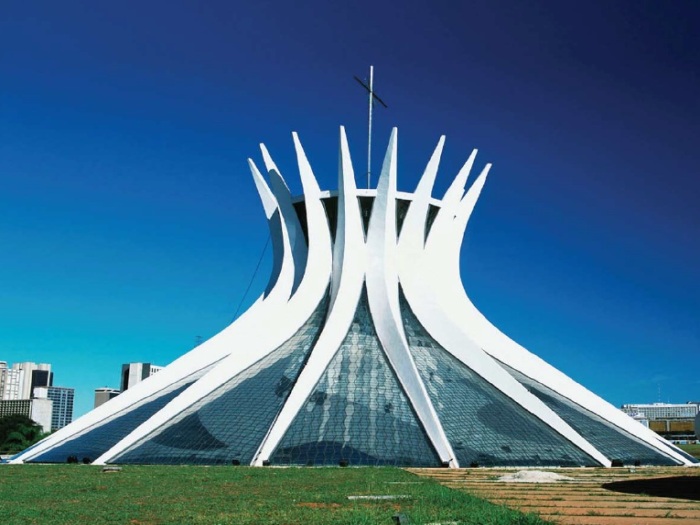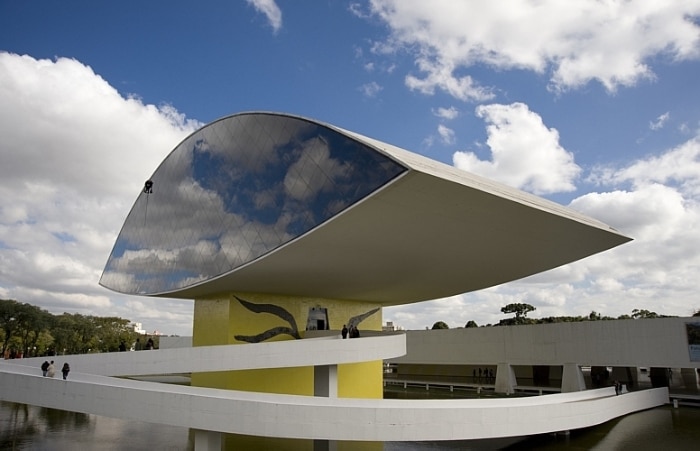Among the first Europeans to come to what is now Brazil were
Jesuit priests. Besides teaching religion, they also taught various arts,
including painting, music, sculpting, and playwriting. The main artists during
this Baroque period of art were centered in Minas Gerais. Some of the more
famous names to come out of this period were the painter Manuel da Costa Ataíde
and the sculptor/architect Aleijadinho.
In 1816, the arrival of the French Artistic Mission changed
the face of visual arts by introducing and transitioning the arts movements
into the Neoclassical era. The key leader in this was Joachim Lebreton, who
reorganized certain arts societies and created the Imperial Academy of Fine
Arts, which was largely responsible for art education and bringing new changes
to Brazilian art. It also opened the door for Romantic painters such as Victor Meirelles
and Pedro Américo. The main difference in European Romanticism and Brazilian
Romanticism is that the Brazilian artists died down the overly dramatic
fascination with death, violence, and the bizarre.
By the late 1800s, Realism had made its way to Brazil, and
artists like Pedro Weingärtner and others began to come on the scene.
There were two main styles of Realism: one depicted more nature and people while the other tended to portray more folk life and landscape.
By the 1920s, modern art was introduced to Brazil but was
met with boos and objects thrown at the artists. Cubism, Surrealism, and
Expressionism (all favorite styles of mine) helped pave the way to modern art,
but it was met with much resistance from the traditionalists. The painter Cândido Portinari helped both
movements come together in a compromised middle ground.
The modern era also brought along modern architecture. The
architect Oscar Niemeyer not only helped design many of the core areas and
planning for the capital city of Brasília (such as its famous cathedral), but
he also had erected several buildings and structures around Brazil as well.
His
style tends to be geometric, yet almost mimicking of nature. I found out he
just passed away about a month ago. I
went to the Oscar Niemeyer Museum in Curitiba; the building looked like a giant
eye. It was pretty impressive when standing inside of it.
Literature has evolved and followed much of the same
European trends throughout the years. The first written works from Brazil were
mainly in the form of letters and first-hand accounts of life in Brazil. During the early years, most artists and poets
were centered in and around Minas Gerais, a boomtown that became the center of
cultural arts due to the gold mining expeditions. Most literature around this
time focused mainly on pastoral and nationalistic writing and poetry. Four key
poets of this early time were Cláudio Manuel da Costa, Tomás Antônio Gonzaga,
Alvarenga Peixoto, Manuel Inácio da Silva Alvarenga, all of whom were arrested
on conspiracy to overthrow the colonial government. Costa and Gonzaga were
permanently banished to Africa.
Neoclassicism led to Romantic poetry with poets like Gonçalves
de Magalhães and Casimiro de Abreu paving the way. The focal points of Romantic literature are a
keen expression of nationalism and nature, and the broader use of casual speech
in writing. This made authors like Joaquim Manuel de Macedo, Manuel Antônio de
Almeida, José de Alencar very popular and widely read.
The transition between the late 1800s and early 1900s was another
change in literary trends as well. It was a shift between the Romantic period
into Realism and the modern era. One writer to emerge was Machado de Assis. I
had downloaded a sample of Dom Casmurro
(in Portuguese) onto my Kindle a couple years ago. From what I remember, it
started out pretty good (based on what I gathered from my slightly passable
Portuguese). The novel actually was significant because of its analysis of
adultery. (I apparently didn’t get that far into the book. Now, I’m going to
just have to buy it.)
Euclides da Cunha was one of the key developers of determinism,
a style that based on the philosophy that for everything that happens, there
are a set of circumstances to which nothing else could happen (a sort of opposite
of free will). His most famous work is a large three-part novel called Os Sertões.
When I was in Porto Alegre, I visited the beautiful (pink!) Casa de
Cultura, which was where poet Mario Quintana once lived. I’ve read some of his
poetry, and I really like it. Simplistically written, it often deals with
death, lost childhood, and time. I should’ve bought a book of his poetry while
I was there.
I also came across Erico Verissimo, also from the southern state
of Rio Grande do Sul. His novel O Tempo e
O Vento is also considered one of the greatest masterpieces of Brazilian
literature. I’ve yet to read it although
I want to; I suppose I could try to order it. I did find an English-language
version of his book called Breve História
da Literatura Brasileira (A Short History of Brazilian Literature) at the Indiana
State University library and read it. It’s actually really interesting; I’d
like to have a copy of that too. Or better yet, I should just take a
book-buying trip to Brazil. (Now to find a sponsor…)
One author that I see a
lot at bookstores here (that I also have yet to read) is Paulo Coelho. He’s
written over 30 novels, including The
Alchemist, The Pilgrimage, Brida, By the River Piedra I Sat Down and Wept, and The Fifth Mountain. Since the late 1980s, he has published a novel
every 1-2 years, saying that if he ever finds a white feather, he takes it as
God’s way of pushing him to start writing a new book. Wherever his influences come
from, he keeps churning them out. (And of course, another set of books to add
to my list of books to buy.)
Up next: Music and Dance











No comments:
Post a Comment